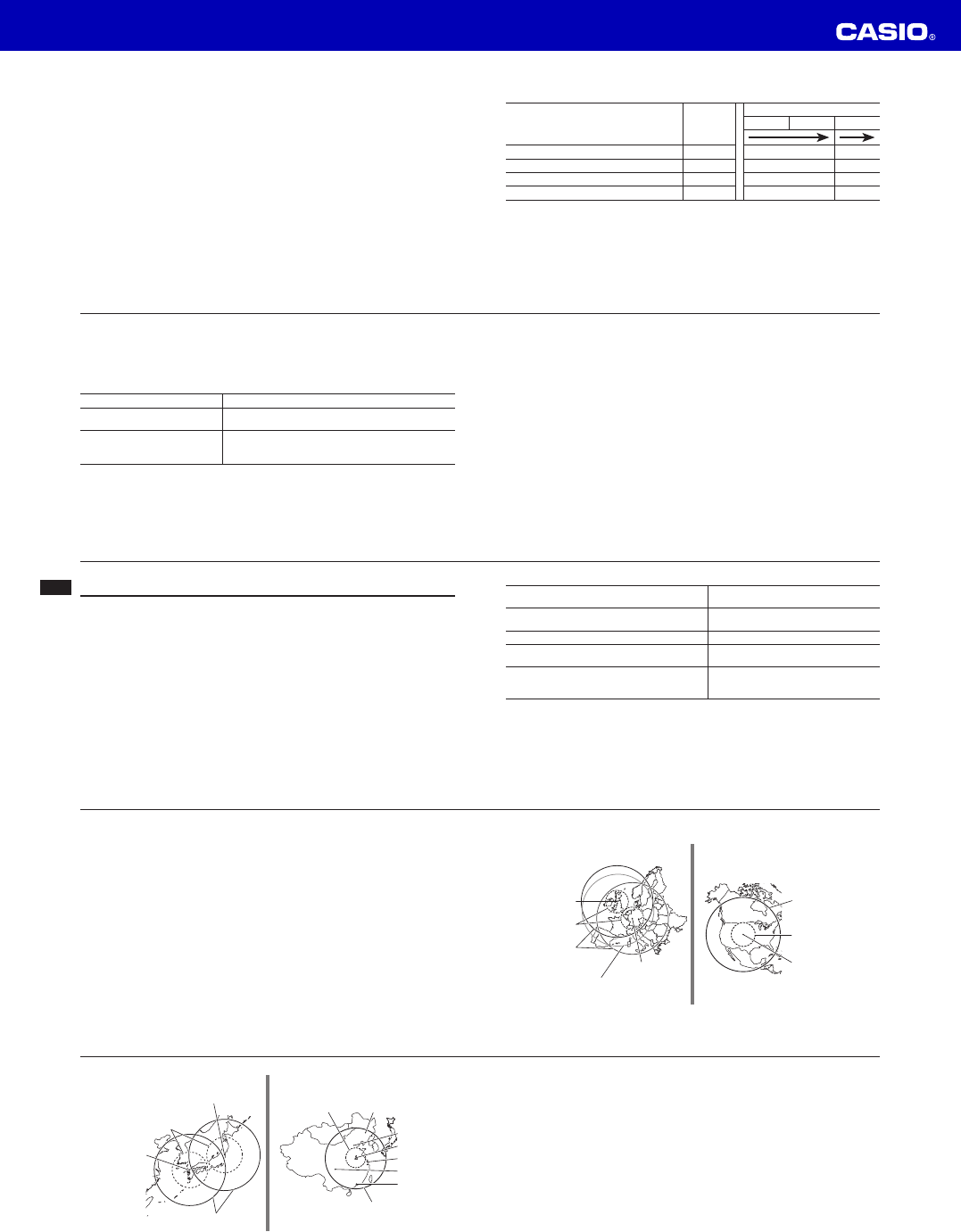
Operation Guide 5142
E-29
Even when the watch is within range of a transmitter, signal reception may be x
impossible due to the effects of geographic contours, structures, weather, the time
of year, the time of day, radio interference, etc. The signal becomes weaker at
distances of approximately 500 kilometers, which means that the infl uence of the
conditions listed above becomes even greater.
Signal reception may not be possible at the distances noted below during certain times
x
of the year or day. Radio interference may also cause problems with reception.
Mainfl ingen (Germany) or Anthorn (England) transmitters: 500 kilometers (310
−
miles)
Fort Collins (United States) transmitter: 600 miles (1,000 kilometers)
−
Fukushima or Fukuoka/Saga (Japan) transmitters: 500 kilometers (310 miles) −
Shangqiu (China) transmitter: 500 kilometers (310 miles) −
As of December 2010, China does not use Daylight Saving Time (DST). If China x
does go to the Daylight Saving Time system in the future, some functions of this
watch may no longer operate correctly.
Using this watch in a country covered by a time calibration signal that is different
x
from the countries it supports may result in incorrect time indication due to local
application of daylight saving time (summer time), etc.
E-28
Japanese Signals Chinese Signal
Fukushima
500 kilometers
1,000 kilometers
Fukuoka/Saga
1,500 kilometers
Changchun500 kilometers
Beijing
Shangqiu
Shanghai
Chengdu
Hong Kong
E-27
Approximate Reception Ranges
UK and German Signals North American Signal
Anthorn
500 kilometers
1,500 kilometers
Mainfl ingen
The Anthorn signal is receivable
within this area.
2,000 miles
(3,000 kilometers)
600 miles
(1,000 kilometers)
Fort Collins
E-26
Important!
The areas covered by
x HNL (HONOLULU) and ANC (ANCHORAGE) are quite far
from the calibration signal transmitters, so certain conditions may cause reception
problems.
When
x HNL (HONOLULU) or HKG (HONG KONG) is selected as the Home City,
only the time and date are adjusted according to the time calibration signal. You
need to switch manually between standard time and daylight saving time (DST) if
required. See “To toggle the Home City time between standard time and daylight
saving time” (page E-51) for information about how to do this.
E-25
If your Home City Code setting is this:
The watch can receive the signal from
the transmitter located here:
LON (LONDON), PAR (PARIS), ATH (ATHENS)
Anthorn (England), Mainfl ingen
(Germany)
HKG (HONG KONG) Shangqiu City (China)
TYO (TOKYO)
Fukushima (Japan), Fukuoka/Saga
(Japan)
HNL (HONOLULU), ANC (ANCHORAGE),
LAX (LOS ANGELES), DEN (DENVER),
CHI (CHICAGO), NYC (NEW YORK)
Fort Collins, Colorado (United States)
E-24
Radio Controlled Atomic Timekeeping
This watch receives a time calibration signal and updates its time setting accordingly.
However, when using the watch outside of areas covered by time calibration signals,
you will have to adjust the settings manually as required. See “Confi guring Current
Time and Date Settings Manually” (page E-55) for more information.
This section explains how the watch updates its time settings when the city code
selected as the Home City is in Japan, North America, Europe, or China, and is one
that supports time calibration signal reception.
E-23
To recover from the sleep state
Move the watch to a well-lit area, press any button, or perform a crown operation
(push in, pull out, rotate).
E-22
Power Saving
Power Saving enters a sleep state automatically whenever the watch is left for a
certain period in an area where it is dark. The table below shows how watch functions
are affected by Power Saving.
There actually are two sleep state levels: “second hand sleep” and “function sleep”.
x
Elapsed Time in Dark Operation
60 to 70 minutes (second hand
sleep)
x
x
Second Hand only stopped, all other functions
enabled
6 or 7 days (function sleep)
All functions, including analog timekeeping, disabled x
World Time Mode time stopped at the point the x
Timekeeping Mode time reached 0:00
The watch will not enter a sleep state between 6:00 AM and 9:59 PM. If the watch x
is already in a sleep state when 6:00 AM arrives, however, it will remain in the sleep
state.
The watch will not enter a sleep state while it is in the Stopwatch Split Mode,
x
Stopwatch Lap Mode, or Countdown Timer Mode.
E-21
Charging Times
Exposure Level (Brightness)
Daily
Operation
*1
Level Change *2
Level 3 Level 2 Level 1
Outdoor sunlight (50,000 lux) 8 minutes 2 hours 23 hours
Window sunlight (10,000 lux) 30 minutes 6 hours 87 hours
Window sunlight on cloudy day (5,000 lux) 48 minutes 9 hours 140 hours
Indoor fl uorescent lighting (500 lux) 8 hours 94 hours – – –
1 Approximate exposure each day to generate power for normal daily operation. *
2 Approximate exposure to take power up one level. *
The above times are for reference only. Actual times depend on lighting conditions.
x
For details about the operating time and daily operating conditions, see the “Power x
Supply” section of the Specifi cations (page E-106).
E-20
A short while after exposing the watch to light after its battery charge has run down x
will cause the
x
Second Hand to move counterclockwise until it stops at second 57
on the face. This indicates that charging has started. See page E-21 for information
about required charging times.
Power Recovery Mode
The watch is designed to go into a power recovery mode that stops hand operation
temporarily whenever power suddenly drops below a certain level due to overuse
of the alarm tone over a short period. Note that all operations are disabled while the
watch is in the power recovery mode.
The hands will move to the correct positions and the watch will resume normal
operation after power recovers (in about 15 minutes). Putting the watch in a location
where it is exposed to light will help power to recover sooner.














